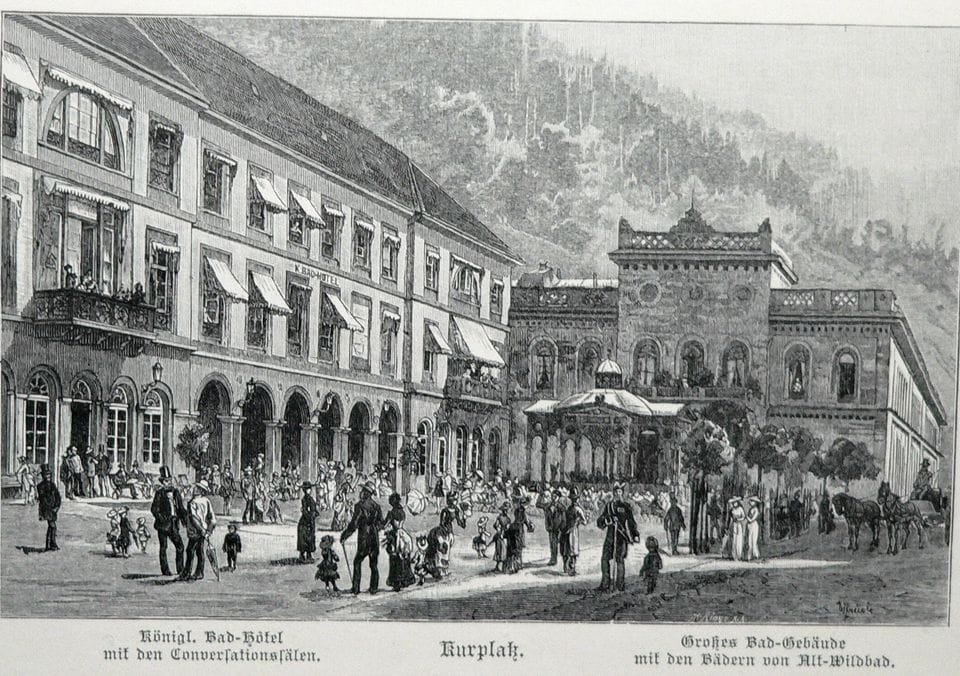Wellness in the Black Forest – today’s “Palais Thermal”, a modern bath complex in the heart of the Black Forest, is one of Europe’s largest and most artistically built historical spas. For several centuries, the exclusive thermal bath has been continuously expanded, becoming more magnificent and luxurious over time. With a spacious sauna and thermal bath landscape spread across four different levels, our famous spa town of Bad Wildbad has established a new standard of bathing culture in the historic “Palais Thermal” since its reopening at the end of 1995, particularly for movement therapy. 1.4 million mosaic tiles adorn the “Moorish Hall” in the entrance area, where a courtyard bistro invites every spa guest to linger. Numerous architects, builders, and artists contributed to the expansion and enhancement of this unique composition of relaxation and history as early as the mid-18th century.
The historic bath was first commissioned by Count Eberhard in the 14th century as a bathhouse and, over the centuries, became a true temple of bathing. In 1847, it was built under the name “Graf-Eberhard-Bad” with a variety of different bathing pools, based on the designs of Nikolaus von Thouret.
The large bathhouse is situated directly above a thermal spring. The original overall design was planned in such a way that the thermal water flowed directly into the various pools. The pools were carved into the natural rock and covered with a layer of sand. The water flowed into the pools through artesian pressure, filling them up to 50 cm. Nikolaus Thouret, a proponent of Romanesque architecture, designed the magnificent neoclassical structure with impressive shapes and refined Gothic details. However, the German architect and painter Thouret did not live to see the entire reconstruction.
After he died in 1845, L. Fischer completed his construction work in 1847. As early as 1863, excess water was stored with an additional thermal water reservoir and the future thermal bath was made more ecological. The bathroom was expanded to include additional spacious bathrooms (=princely baths). From 1896 to 1967, the large bathing building was supplemented with a Moorish-style reception hall, as well as four “princely baths” and a new main entrance. At the turn of the century the windows were given stunning glazing with Art Nouveau motifs and the new magnificent entrance hall was decorated with a charming mosaic floor.
The walls were given high-quality cladding made of elegant, colorful marble. Referred to as a former large or royal bath building, the thermal bath was renamed Graf-Eberhard-Bad in 1860. Count Eberhard II, whose “Escape from Wildbad” depicted in a terracotta relief by Hermann Heidel on the north side served as the exclusive namesake. From 1970 to 1977, the former attached baths, in a quiet location surrounded by forests, served as a spa house. To do this, the huge building had to be expanded and strengthened. Even back then, an extensive repertoire of thermal fan baths, underwater massages, and physiotherapy formed the basis for the first-class wellness and health offerings, which are now appreciated by numerous visitors and wellness hotel guests.
In 1986/87 the roof was renovated and the facade of the building was restored. From 1991 to 1995 the building was listed for around 33 million DM and converted into a nostalgic adventure pool with a sauna area and steam bath. The historic bathing area was restored with great care and attention to detail so that guests can still enjoy the fantastic style of the 1920s to this day.
In December 1995, the former Graf-Eberhard-Bad was reopened as the “Palais Thermal”. Its function as a health resort faded behind the demand of numerous tourists and short vacationers who were looking for a place to relax in the beautiful nature of the Black Forest. In 2011, another fantastic element of the wellness pool was opened. An additional outdoor thermal water pool, protected from view by a modern tent membrane construction, offers a relaxing place to rest right in nature in both summer and winter.
With passionate financial, planning, and artistic effort, a listed building was transformed into a luxurious bathing area with a unique and special flair. A wellness temple that connects the Orient and Occident. Guests of our affiliated wellness hotel in the northern Black Forest benefit
from our bathrobe entrance and can let yourself be royally pampered in the numerous massage, sauna, and bathing areas.

